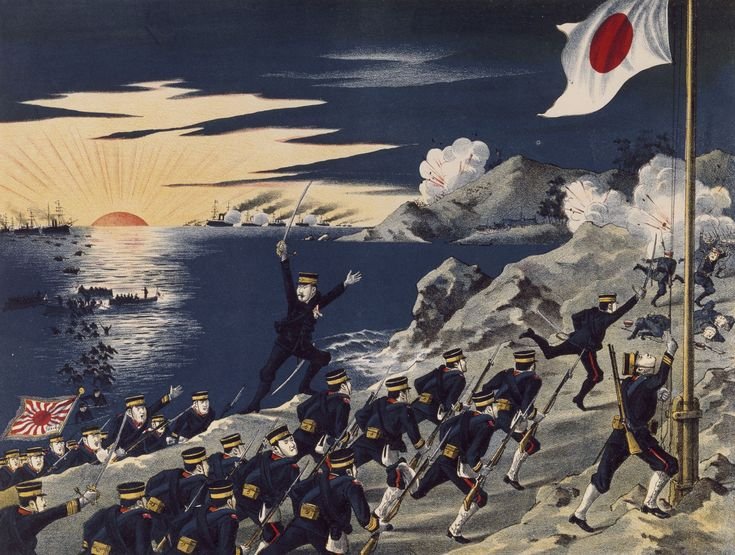The Rise of an Empire: How Japanese Imperialism Shaped Asia’s Modern History

Japanese imperialism represents one of the most significant and transformative periods in East Asian history. Between the late 19th and mid-20th centuries, Japan transitioned from a feudal society to an industrial and militarised empire with ambitions to dominate Asia. This expansionist phase was marked by wars, colonial occupations, and aggressive foreign policies that reshaped the geopolitics of the region. While Japan’s imperialism was driven by modernisation and economic necessity, its consequences were catastrophic, leaving a legacy of conflict, cultural suppression, and human suffering.
Japanese imperialism can be traced back to the Meiji Restoration of 1868, a period of intense political, economic, and social reform. Determined to avoid the fate of colonised nations such as China and India, Japan sought to modernise rapidly, adopting Western political systems, industrial practices, and military strategies. This modernisation created a robust industrial economy but also heightened Japan’s dependence on foreign resources such as coal, iron, and oil.
Phases of Japanese Imperial Expansion
Emergence as a Regional Power: The Sino-Japanese War (1894–1895)
Japan’s rise as a military power was evident in the First Sino-Japanese War, where it decisively defeated China. The war ended with the Treaty of Shimonoseki, which granted Japan control over Taiwan and the Pescadores Islands and nominal control over the Liaodong Peninsula (later rescinded due to Western pressure). This victory signaled Japan’s emergence as a dominant power in East Asia.
The Russo-Japanese War (1904–1905)
The Russo-Japanese War (1904–1905) was a transformative conflict that reshaped the balance of power in the early 20th century. It marked the first time an Asian nation defeated a European power in modern warfare, establishing Japan as a global power and signaling the decline of Russia’s influence in East Asia. The war stemmed from competing imperial ambitions, with Japan seeking control over Korea and parts of Manchuria to secure economic resources and strategic advantages, while Russia aimed to maintain dominance in the region and secure access to a warm-water port. Diplomatic negotiations failed, and Japan launched a surprise attack on the Russian fleet at Port Arthur in February 1904, initiating the war.
Throughout the conflict, Japan demonstrated superior military preparedness and strategy. Major battles such as the Siege of Port Arthur and the Battle of the Yalu River showcased Japan’s tactical prowess, while victories at Liaoyang and Mukden solidified its control over southern Manchuria. The most decisive moment came in the Battle of Tsushima, where Japan’s navy annihilated the Russian Baltic Fleet, securing naval dominance. These successes forced Russia into a defensive position and highlighted its military and logistical weaknesses.
The war concluded with the Treaty of Portsmouth in September 1905, mediated by U.S. President Theodore Roosevelt. The treaty granted Japan control over Korea, the southern half of Sakhalin Island, and significant territorial leases in Manchuria, while Russia acknowledged Japan’s dominance in the region. Despite its victory, Japan faced domestic dissatisfaction over the treaty’s limited concessions, while Russia grappled with internal unrest, culminating in the 1905 Russian Revolution.
The consequences of the Russo-Japanese War were profound. Japan’s victory challenged the global perception of Asian nations and inspired anti-colonial movements across the world. It also marked the beginning of Japan’s imperial expansion, with Korea formally annexed in 1910. For Russia, the war exposed military and administrative weaknesses, shifting its focus westward and weakening its influence in East Asia. The war’s legacy extended beyond geopolitics, fostering militarism in Japan and contributing to the rivalries that eventually led to World War I.
Annexation of Korea (1910)
The annexation of Korea by Japan in 1910 marked the start of a period of harsh colonial rule that lasted until 1945. Japan sought to fully integrate Korea into its empire, using political manipulation to seize control. After weakening Chinese and Russian influence over Korea through victories in the First Sino-Japanese War (1894–1895) and the Russo-Japanese War (1904–1905), Japan forced Korea to sign the Eulsa Treaty in 1905, reducing it to a protectorate. In 1910, the Japan-Korea Annexation Treaty formally dissolved the Korean Empire, allowing Japan to govern Korea through the Government-General of Korea, which excluded Koreans from all meaningful political participation.
Under Japanese rule, Korean culture and identity were systematically suppressed. The Korean language was banned in schools and official use, with Japanese becoming mandatory. Traditional Korean names were replaced with Japanese ones under the Sōshi-kaimei policy. Korean religious practices and cultural ceremonies were also heavily restricted, as Japan sought to assimilate Koreans into its cultural framework. This erasure of identity was deeply resented by the Korean population.
Economically, Japan exploited Korea’s resources for its own benefit. Land redistribution policies dispossessed many Korean farmers, transferring land to Japanese settlers and the government. Korea’s industries were developed, but the profits flowed to Japan. Farmers were forced to produce cash crops like rice for export, which led to widespread food shortages and famine in Korea. The Japanese government also used forced labor to support its industrial and military efforts, especially during World War II, when millions of Koreans were sent to work in mines, factories, and construction sites under harsh conditions.
Japanese repression extended to military conscription and the exploitation of Korean women. From 1938 onward, Koreans were drafted into the Japanese army, often serving in dangerous roles. Korean women were forced to serve as “comfort women” for the Japanese military, a traumatic legacy that remains a source of tension between Korea and Japan to this day. Any dissent against Japanese rule was met with brutal suppression. The March 1st Movement of 1919, a peaceful protest demanding Korean independence, was violently crushed, resulting in thousands of deaths and arrests. Activists and intellectuals were constantly monitored, and resistance leaders were often imprisoned or executed.
Despite these challenges, Koreans resisted Japanese rule in various ways. The Provisional Government of the Republic of Korea, established in Shanghai in 1919, sought international support for Korean independence. Guerrilla fighters organized attacks against Japanese forces, particularly in Manchuria. Meanwhile, cultural resistance efforts helped preserve Korean traditions and language in secret.
The Mukden Incident and the Occupation of Manchuria (1931)
In 1931, Japan engineered the Mukden Incident to justify its military aggression in northeastern China. Japanese officers staged a minor explosion near a railway owned by Japan’s South Manchuria Railway Company and falsely blamed Chinese forces. Using this fabricated event as a pretext, the Japanese Kwantung Army launched a full-scale invasion of Manchuria. Within months, Japan established the puppet state of Manchukuo, installing the last Qing emperor, Puyi, as its nominal ruler. Despite international condemnation, including by the League of Nations, Japan refused to relinquish Manchuria, instead withdrawing from the League in 1933. This marked the beginning of Japan’s unchecked military expansion across Asia.
Manchuria became a base for further aggression, with Japan exploiting the region’s vast natural resources, including coal, iron, and agricultural products, to fuel its growing war machine. The occupation also saw harsh treatment of local populations, including forced labor, mass displacements, and the establishment of biological warfare facilities, such as the infamous Unit 731, which conducted inhumane experiments on civilians and prisoners of war.
The Second Sino-Japanese War (1937–1945)
In 1937, Japan escalated its aggression by launching a full-scale invasion of China, triggering the Second Sino-Japanese War. Hostilities began with the Marco Polo Bridge Incident near Beijing, a skirmish that served as the casus belli for the invasion. Japanese forces quickly advanced, capturing major cities like Shanghai, Beijing, and Nanjing.
The occupation of Nanjing resulted in one of the war’s most infamous atrocities, the Nanjing Massacre (December 1937–January 1938). Over a period of six weeks, Japanese troops committed widespread atrocities, including mass executions, sexual violence, and looting. Estimates of the death toll range from 200,000 to 300,000, with tens of thousands of women raped. The massacre remains a deeply sensitive issue in Sino-Japanese relations.
Japan’s campaign in China was marked by a scorched-earth strategy, including the deliberate targeting of civilian populations and infrastructure. Chemical and biological weapons were also used, causing immense suffering. Despite early successes, Japan faced stiff resistance from the Chinese Nationalist government under Chiang Kai-shek and Communist forces led by Mao Zedong, prolonging the conflict into a drawn-out war of attrition.
World War II and the Greater East Asia Co-Prosperity Sphere
Japan’s imperial ambitions reached their peak during World War II, when it sought to establish the Greater East Asia Co-Prosperity Sphere. Officially promoted as a movement to liberate Asian nations from Western colonialism, the initiative was, in reality, a cover for Japanese domination of the region’s resources, economies, and political systems.
In December 1941, Japan attacked Pearl Harbour, bringing the United States into the war. Following this, Japan launched a series of rapid invasions across Southeast Asia, capturing the Philippines, Malaya, Singapore, Indonesia, and Burma. Initially, many local populations welcomed Japanese forces as liberators from Western colonial rule. However, Japan’s brutal occupation policies quickly alienated them.
Exploitation and Atrocities in Occupied Territories
Japan’s occupation was characterised by economic exploitation, forced labor, and widespread human rights abuses. Millions of civilians were conscripted into labor, often under inhumane conditions, to support Japan’s war effort. In territories like Indonesia and the Philippines, resources were stripped to feed Japan’s military-industrial complex, causing widespread famine and suffering among local populations.
The use of “comfort women”, women and girls forced into sexual slavery to serve the Japanese military, was another dark aspect of the occupation. Victims came from Korea, China, and other occupied regions, enduring horrific abuse.
Japanese military forces also committed numerous atrocities, including massacres, the looting of cultural treasures, and the destruction of local economies. The Bataan Death March in the Philippines and mass killings in Indonesia and Malaya further exemplified the brutality of Japanese rule.
Decline of the Japanese Empire
Despite its initial territorial gains, Japan’s empire began to unravel as Allied forces mounted counteroffensives in the Pacific and Southeast Asia. Key battles such as Midway (1942) and Guadalcanal (1942–1943) turned the tide of the war against Japan. By 1944, the Japanese military was stretched thin, and its territories were being reclaimed by Allied forces.
The war culminated in Japan’s surrender on August 15, 1945, following the atomic bombings of Hiroshima and Nagasaki and the Soviet invasion of Manchuria. Japan’s imperial ambitions left a legacy of destruction, suffering, and unresolved tensions across Asia, particularly in Korea and China, where the scars of occupation remain deeply felt to this day.
Consequences of Japanese Imperialism
- Colonial Rule and Cultural Suppression
In Korea, Taiwan, and occupied China, Japan imposed its culture and language while exploiting local resources. Koreans were forced to adopt Japanese names, and traditional practices were suppressed.Economic systems in colonies were restructured to benefit Japan, often at the expense of local development.
- Wartime Atrocities
Japanese forces committed widespread atrocities, including mass killings, forced labor, and the use of “comfort women” (sex slaves) from occupied territories.Events like the Nanjing Massacre and Unit 731’s biological experiments left scars that remain unresolved in modern diplomacy.
- Regional Destabilisation
Japan’s imperial policies contributed to prolonged instability in East Asia. Its occupation of China furled resistance movements, while its actions in Southeast Asia disrupted local economies and governance.
- End of Imperial Ambitions
Japan’s defeat in World War II in 1945 ended its imperial ambitions. The Allied occupation forced Japan to renounce territorial claims, and former colonies gained independence. However, the economic and social impacts of Japanese imperialism persisted long after its collapse.
Conclusion
Japanese imperialism was a period of rapid expansion, driven by modernization, economic necessity, and nationalist ambitions. It reshaped East Asia, bringing industrial and military advancements but also causing immense suffering and conflict. The impacts of this era are still felt today, influencing geopolitical dynamics and historical memory in the region. As Japan continues to grapple with its imperialist legacy, its history serves as a reminder of the devastating consequences of militarism and expansionism.


